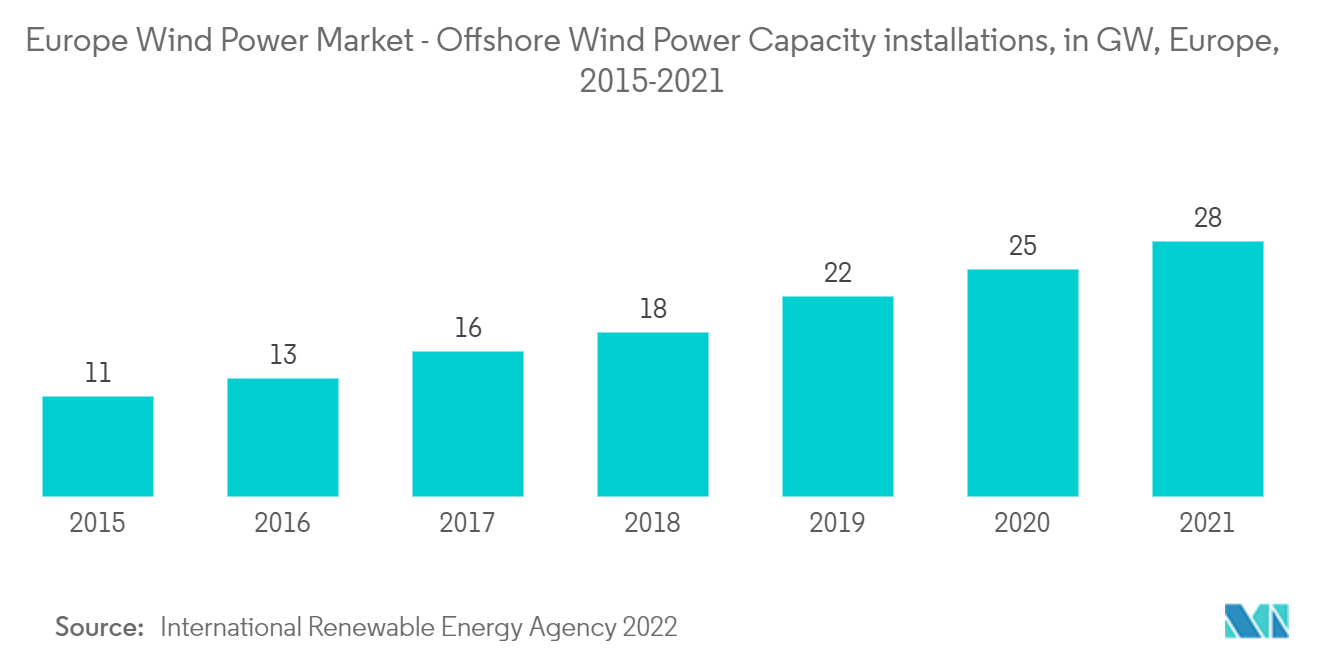Market Trends of Europe Wind Power Industry
This section covers the major market trends shaping the Europe Wind Power Market according to our research experts:
Offshore Segment to Witness Significant Growth in the Market
- Europe is the leader in offshore wind and is home to the largest operational wind farms across the globe. The region's offshore capacity is large enough to meet the electricity needs in Europe, which will only continue to grow within the upcoming years.
- Installation of wind farms in the offshore area is becoming a lucrative market because of the higher wind speed compared to onshore wind speed.
- In the future, deploying offshore wind energy is at the core of delivering the European Green Deal. Europe's cumulative offshore wind energy capacity reached a peak of around 28 gigawatts at the end of 2021, considering that the European Union needs 32 GW of new wind capacity each year until 2030 to reach its carbon neutrality target by 2050.
- Also, the European Commission launched a public consultation on renewables permitting in January 2022 to accelerate progress towards the 40% renewable energy target by 2030. This, in turn, culminates in the growth of wind power installations across the country.
- Moreover, in April 2022, UK Prime Minister Boris Johnson presented a plan to boost Britain's energy security, including an increased target of up to 50 GW of operating offshore wind capacity by 2030. This will, in turn, support the growth of offshore wind energy generation across the country.
- Furthermore, in July 2022, the United Kingdom Department for Business, Energy, and Industrial Strategy awarded Orsted a contract for difference for its Hornsea 3 offshore wind farm. The project has a capacity of 2,852 MW and will produce enough low-cost, clean, renewable electricity to power 3.2 million UK homes.
- Hence, the offshore wind power market is expected to be positive during the forecast period.

Germany Likely to Dominate the Market
- Germany has vast reserves of high-quality, cost-competitive wind energy resources. Owing to this, Germany held the first-largest installed wind power capacity in the European region, with a total installed capacity of 63.8 GW in 2021. This installed capacity is enough to power more than 3.5 million homes in the country.
- With the increasing need for an affordable, reliable, clean, and diverse electricity supply, the government and utilities across the nation are increasingly considering wind power as a solution. Moreover, with the country's unparalleled wind resources, there are ample opportunities to maximize the economic and environmental benefits associated with wind energy development.
- Moreover, the country has set a target to achieve 65% of the power generation from renewable energy and plans to shut down nuclear power plants by 2022 and phase-out coal power by 2038. The expected growth in the offshore wind industry is insufficient for achieving this target. Adding to this, the slowdown in the onshore wind industry has become a significant concern for meeting the renewable energy target.
- In September 2022, Vattenfall AB obtained the right to develop the N-7.2 offshore wind power project off the German North Sea coast after having exercised its right of entry. The project is expected to get commissioned by 2027, and will be having an output of 980 MW with annual generation corresponding to the consumption of more than one million German households.
- In November 2021, BASF and Orsted concluded a 25-year power purchase agreement, under which BASF will offtake the output of 186 MW from Orsted's planned Borkum Riffgrund 3 Offshore Wind Farm in the German North Sea.
- Owing to the such points, Germany is expected to dominate the European Wind Energy Market during the forecast period.


